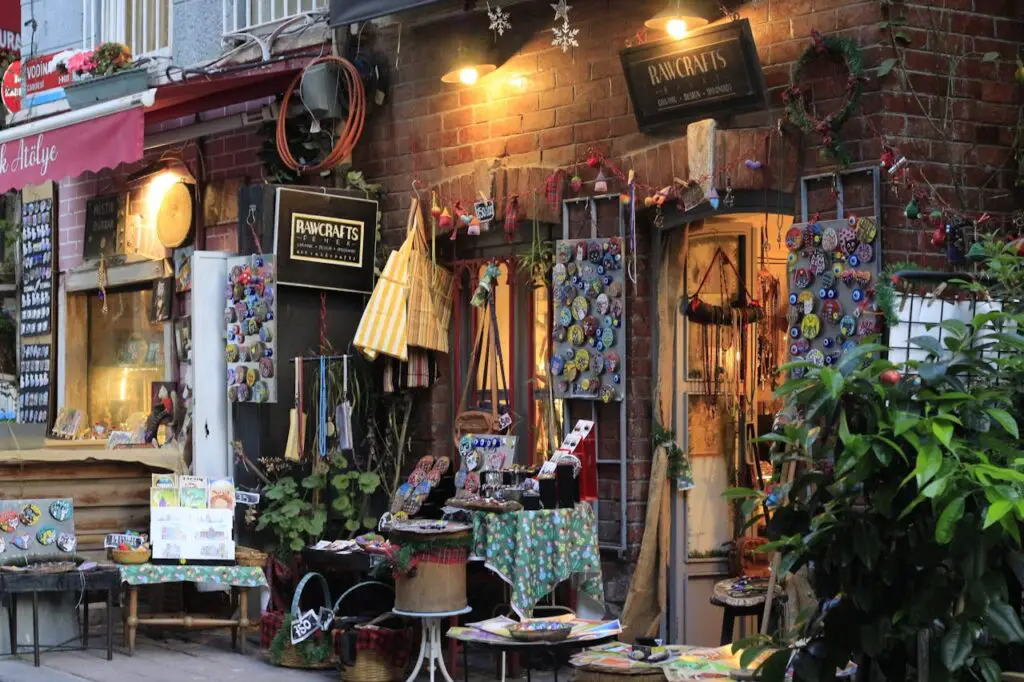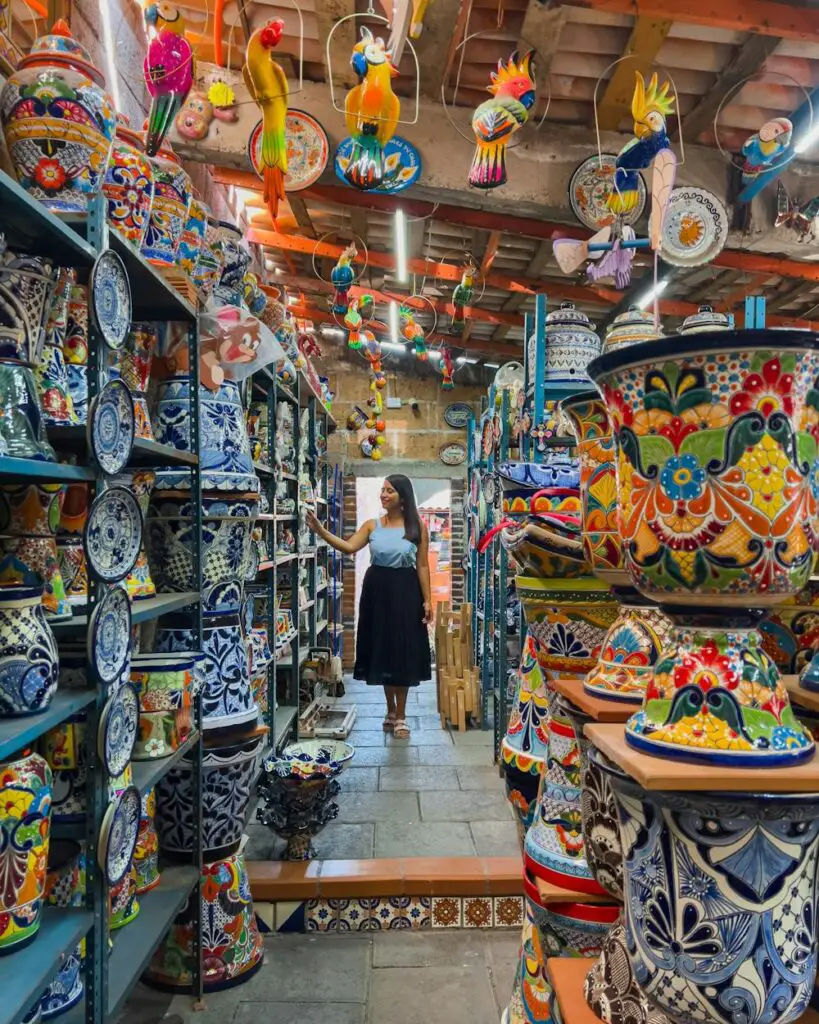Looking for Authentic Turkish Souvenirs? In a world of mass-produced souvenirs and generic keepsakes, Turkey stands as a treasure trove of authentic craftsmanship and cultural heritage. The true value of a Turkish souvenir lies not just in its beauty or utility, but in the centuries of tradition it represents, the stories it tells, and the connection it creates to this extraordinary land at the crossroads of civilizations.
This guide will take you beyond the tourist trinkets to discover souvenirs that authentically represent Turkey’s rich cultural tapestry. We’ll explore the history and significance behind traditional Turkish crafts, help you distinguish genuine articles from imitations, and guide you to the best places to find these cultural treasures. Whether you’re drawn to textiles woven using techniques passed down through generations, ceramics painted with designs that date back to the Ottoman court, or culinary delights that capture the essence of Turkish hospitality, you’ll discover meaningful mementos that will bring a piece of Turkey into your home and heart.
Turkish Carpets and Kilims: Woven Stories

Perhaps no item is more emblematic of Turkish craftsmanship than the carpet. These aren’t merely decorative floor coverings—they’re narratives woven in wool and silk, with designs that tell stories of tribal migrations, family traditions, and regional identities.
The Cultural Significance
Carpet weaving in Anatolia dates back thousands of years, with techniques and motifs passed down through generations, primarily by women. Each region developed distinctive styles, colors, and symbols, creating a rich visual language. Traditional motifs often carry specific meanings—fertility, protection against evil, good fortune, or family unity.
Types of Turkish Carpets
Anatolian Pile Carpets
Hand-knotted carpets with a plush surface, created by tying thousands of individual knots onto the warp threads.
Regional Varieties:
- Hereke: Extraordinarily fine silk carpets with intricate designs, once made exclusively for Ottoman palaces
- Kayseri: Known for fine wool and silk carpets with floral motifs
- Konya: Featuring bold geometric designs and rich colors
- Milas: Recognized by their pastel colors and distinctive prayer rug designs
Kilims
Flat-woven carpets without pile, created by interweaving the warp and weft threads to form the design.
Cultural Insight: Kilims often feature symbols that tell stories about the weaver’s life—triangles for female fertility, hooks for protection from evil, and birds for happiness and joy.
Sumak and Cicim
Specialized flat-weaving techniques that create textured surfaces and intricate patterns.
Identifying Authentic Carpets
Materials: Genuine Turkish carpets use natural materials—primarily wool, cotton, and silk. Wool should feel springy and slightly oily, while silk has a distinctive sheen that changes when viewed from different angles.
Construction: Turn the carpet over to examine the back. Hand-knotted carpets show the pattern clearly on both sides (though not identical). Machine-made carpets have a backing or uniform appearance on the reverse.
Dyes: Traditional carpets use natural dyes from plants, insects, and minerals. These create subtle variations in color (abrash) that synthetic dyes lack. Natural dyes age beautifully, often becoming more vibrant with time.
Knot Density: Higher quality carpets have more knots per square inch. You can check this on the back of the carpet—the finer and more visible the individual knots, the higher the quality.
Where to Buy Authentic Carpets
For detailed information about where to find authentic carpets in different Turkish cities, see our article on “Best Shopping Experiences in Turkey by City: Istanbul, Antalya, Cappadocia, and More”.
Recommended Establishments:
- Istanbul: Ethnicon in Arasta Bazaar; Dhoku for contemporary designs
- Cappadocia: Galerie Ikman in Göreme; Sultan Carpets in Uçhisar
- Konya: Mevlana Carpet Cooperative
Cultural Experience: A proper carpet shopping experience involves tea, conversation, and education. Reputable dealers will take time to explain different styles, materials, and techniques, showing you many options without pressure.
Turkish Ceramics: Painted Poetry
Turkish ceramic art reaches back to the Iznik pottery of the 15th and 16th centuries, when Ottoman court artists created pieces of such beauty and technical perfection that they transformed the medium forever.
The Cultural Significance
Iznik ceramics, named after the town where they were produced, adorned the most important Ottoman buildings, including Topkapı Palace and Süleymaniye Mosque. The distinctive floral designs, featuring tulips, carnations, and cypress trees, along with the characteristic cobalt blue, turquoise, and coral red colors, became synonymous with Ottoman artistic achievement.
Types of Turkish Ceramics
Iznik-Style Ceramics
Contemporary pieces inspired by classical Ottoman designs, featuring floral motifs and geometric patterns in vibrant colors.
Cultural Insight: The tulip motif, prominent in Iznik designs, was so beloved in Ottoman culture that the early 18th century was known as the “Tulip Period,” a time of peace, artistic flourishing, and cultural refinement.
Kütahya Ceramics
Known for more whimsical, colorful designs, often featuring birds, fish, and human figures.
Çanakkale Ceramics
Distinctive pottery from the Dardanelles region, known for its unique forms and often humorous figurines.
Avanos Pottery
Red clay pottery from Cappadocia, continuing a tradition that dates back to Hittite times.
Identifying Authentic Ceramics
Craftsmanship: Hand-painted ceramics show slight variations in brushstrokes and minor imperfections that give them character. Machine-produced pieces have perfectly uniform patterns.
Signature: Quality pieces are signed by the artist, usually on the bottom.
Materials: Authentic pieces have a satisfying weight and sound when gently tapped.
Design Integrity: Traditional designs follow specific compositional rules and color palettes. While contemporary artists may innovate, quality pieces maintain a connection to these traditions.
Where to Buy Authentic Ceramics
Recommended Establishments:
- Istanbul: Iznik Classics in Arasta Bazaar; Ceramics Workshop in Grand Bazaar
- Kütahya: The city itself is the center of ceramic production; visit small workshops
- Cappadocia: Chez Galip in Avanos, where you can watch pottery being made
Cultural Experience: Many workshops offer demonstrations or even hands-on experiences where you can try creating your own piece.
Turkish Textiles: Threads of Tradition
Beyond carpets, Turkey produces an array of exquisite textiles that showcase the country’s weaving heritage and attention to detail.
The Cultural Significance
Textiles have been central to Turkish culture for millennia, from the elaborate Ottoman court garments to the practical yet beautiful towels and linens used in hammams (Turkish baths) and homes. These textiles reflect both the Islamic appreciation for geometric pattern and the Turkish love of floral motifs.
Types of Turkish Textiles
Peştemal (Turkish Towels)
Lightweight, flat-woven cotton towels traditionally used in hammams. Now popular worldwide for their quick-drying properties and versatility.
Cultural Insight: In traditional hammams, different peştemal designs indicated the status of the bather and the attendant.
Turkish Cotton Towels and Bathrobes
Plush, absorbent towels made from Turkish cotton, known for its long fibers and exceptional softness.
Silk Scarves and Textiles
Hand-painted or block-printed silk items, often featuring traditional Ottoman or contemporary Turkish designs.
Suzani Embroidery
Colorful embroidered textiles featuring floral and symbolic motifs, influenced by Central Asian traditions.
Identifying Authentic Textiles
Materials: Quality Turkish textiles use natural fibers—primarily cotton and silk. Turkish cotton should feel soft yet substantial.
Weaving: Examine the density and evenness of the weave. Quality pieces have tight, consistent weaving with straight edges.
Finishing: Check hems and edges for neat, secure stitching.
Dyes: Natural dyes create richer, more complex colors that may have subtle variations.
Where to Buy Authentic Textiles
Recommended Establishments:
- Istanbul: Jennifer’s Hamam in Arasta Bazaar; Abdulla Natural Products in Grand Bazaar
- Bursa: The historic silk market (Koza Han)
- Cappadocia: Tribal Collections in Göreme for traditional textiles
Turkish Metalwork: Crafted in Copper and Silver
The art of metalworking has flourished in Turkey since ancient times, with copper, brass, and silver crafted into both practical and decorative items of extraordinary beauty.
The Cultural Significance
Metalwork in Turkey reflects influences from Byzantine, Seljuk, and Ottoman traditions. Copper, in particular, holds special significance in Turkish culture, used for everything from cooking vessels to ritual objects. The distinctive sound of coppersmiths hammering their wares was once the heartbeat of many Turkish market districts.
Types of Turkish Metalwork
Copper Cookware
Traditional hand-hammered copper pots, pans, and serving dishes, often tinned on the inside for food safety.
Cultural Insight: Different shapes serve specific culinary purposes—the narrow-necked ibrik for coffee, the wide sahan for stews, and the distinctive double-boiler bain-marie for delicate sauces and desserts.
Coffee Sets
Ornate copper or brass coffee pots (cezve) and accompanying cups, often decorated with intricate engravings or embossing.
Silver Filigree
Delicate jewelry and decorative items created by twisting fine silver wire into intricate patterns.
Hammered Brass and Copper Trays
Decorative trays with embossed or engraved designs, traditionally used for serving Turkish coffee or tea.
Identifying Authentic Metalwork
Craftsmanship: Hand-hammered copper has a distinctive texture with subtle hammer marks. Machine-produced items have a perfectly smooth surface.
Weight: Quality pieces have substantial weight for their size.
Decoration: Hand-engraved or embossed designs show depth and variation. Look for the artist’s signature or workshop stamp.
Patina: Authentic older pieces develop a natural patina that enhances their character.
Where to Buy Authentic Metalwork
Recommended Establishments:
- Istanbul: Coppersmiths in the Grand Bazaar; Timuçin Copper Workshop
- Gaziantep: Almacı Pazarı (Copper Bazaar)
- Ankara: Coppersmiths in the historic Çıkrıkçılar Yokuşu
Turkish Jewelry: Adorned in Gold and Silver
Turkish jewelry combines influences from Byzantine, Ottoman, and modern design traditions, creating distinctive pieces that range from intricate gold filigree to contemporary silver designs.
The Cultural Significance
Jewelry in Turkey goes beyond adornment—it often serves as a store of wealth, a marker of social status, and a talisman for protection. Traditional wedding jewelry, in particular, carries deep cultural significance, with specific pieces symbolizing the bride’s transition to married life.
Types of Turkish Jewelry
Gold Jewelry
Turkey has a long tradition of 22K and 24K gold jewelry, often featuring intricate filigree work or hammered textures.
Cultural Insight: The Grand Bazaar in Istanbul houses thousands of jewelry shops, with entire sections (like Kalpakçılar Caddesi or “Gold Street”) dedicated to gold jewelry.
Evil Eye (Nazar Boncuğu) Jewelry
The distinctive blue glass beads believed to ward off the evil eye, incorporated into bracelets, necklaces, and decorative items.
Cultural Insight: The nazar is so central to Turkish culture that you’ll see it everywhere—hanging in homes, offices, cars, and even pinned to babies’ clothing.
Silver Jewelry
Often featuring turquoise, coral, or other semi-precious stones, with designs ranging from traditional Ottoman motifs to contemporary Turkish designs.
Authentic Ottoman-Style Jewelry
Reproductions of historical designs featuring techniques like niello (black inlay on silver) and micro-mosaic work.
Identifying Authentic Jewelry
Hallmarks: Turkish gold and silver should be hallmarked with a stamp indicating purity (e.g., 925 for sterling silver, 22K for gold).
Craftsmanship: Examine clasps, settings, and finishing—quality pieces show attention to detail even in areas not immediately visible.
Materials: Genuine stones have natural variations; perfect uniformity often indicates synthetic materials.
Weight: Gold and silver have distinctive weights—pieces that feel too light may be plated rather than solid.
Where to Buy Authentic Jewelry
Recommended Establishments:
- Istanbul: Grand Bazaar jewelry shops; Sevan Bıçakçı for high-end designer pieces
- Mardin: Silver filigree workshops in the old town
- Midyat: Known for telkari (filigree) silver work
Turkish Leather Goods: Crafted with Heritage
Turkey has been renowned for its leather craftsmanship since Ottoman times, when guild systems ensured the highest standards of quality and artistry.
The Cultural Significance
The tanning and working of leather has deep roots in Turkish culture, particularly in cities like Istanbul and Konya. Traditional techniques for tanning, dyeing, and tooling leather have been passed down through generations, creating a distinctive Turkish leather aesthetic that combines durability with beauty.
Types of Turkish Leather Goods
Leather Jackets and Coats
Turkey is famous for high-quality leather outerwear, from classic designs to fashion-forward styles.
Bags and Wallets
Ranging from traditional embossed designs to contemporary minimalist pieces.
Ottoman-Inspired Leather Goods
Items featuring traditional techniques like leather marbling or gold-leaf application.
Leather-bound Books and Stationery
Journals, albums, and boxes covered in hand-tooled or painted leather.
Identifying Authentic Leather
Smell: Genuine leather has a distinctive natural aroma that synthetic materials cannot replicate.
Texture: Quality leather has natural variations in grain and texture. Perfect uniformity suggests synthetic materials.
Edges: Examine how edges are finished—quality pieces have clean, well-finished edges.
Lining: Check the interior lining and stitching for quality construction.
Where to Buy Authentic Leather
Recommended Establishments:
- Istanbul: Grand Bazaar leather shops; Serdar Leather in Sultanahmet
- Konya: Traditional leather workshops in the historic center
- Ankara: Kızılarık Leather in Çıkrıkçılar Yokuşu
For more information about pricing and bargaining when shopping for leather goods, see our article on “Shopping in Turkey: Prices, Bargaining Tips, and What to Expect”.
Turkish Lamps and Lanterns: Illuminating Art
Few items capture the magical atmosphere of Turkey like the colorful mosaic glass lamps that cast their kaleidoscopic light in homes, restaurants, and shops throughout the country.
The Cultural Significance
These distinctive lamps evolved from the oil lamps used in Ottoman mosques and palaces, where light was both practical and symbolic—representing divine illumination. Today’s decorative versions maintain this connection between beauty and light, creating ambiance that feels distinctly Turkish.
Types of Turkish Lamps
Mosaic Glass Lamps
Handcrafted lamps made by embedding small pieces of colored glass into a plaster base, creating intricate patterns when illuminated.
Cultural Insight: The designs often incorporate traditional Ottoman motifs and geometric patterns inspired by Islamic art, where geometry was used to express cosmic harmony.
Copper and Brass Filigree Lamps
Metal lamps with intricate cutout designs that cast patterned shadows.
Gourd Lamps
Unique lamps made from dried gourds, hand-drilled with tiny holes to create delicate light patterns.
Identifying Authentic Lamps
Craftsmanship: Examine how glass pieces are set—they should be evenly spaced with clean lines of grout between them.
Materials: Quality lamps use genuine glass (not plastic) and solid metal (not plated) for the frame.
Wiring: While traditional lamps used oil, modern versions should have safe, well-installed electrical components.
Weight: Authentic mosaic lamps have substantial weight due to the glass and plaster construction.
Where to Buy Authentic Lamps
Recommended Establishments:
- Istanbul: Grand Bazaar lamp shops; Osmanli Lighting in Sultanahmet
- Cappadocia: Numerous shops in Göreme and Ürgüp
Turkish Culinary Treasures: Flavors to Take Home
Turkey’s rich culinary heritage offers many portable delicacies that make meaningful souvenirs, allowing you to bring the flavors of your journey into your home kitchen.
The Cultural Significance
Food in Turkey is deeply intertwined with hospitality, family traditions, and regional identity. Bringing home Turkish culinary products connects you to this aspect of the culture and allows you to share a taste of Turkey with friends and family.
Types of Culinary Souvenirs
Spices and Herbs
Turkey’s spice bazaars offer a rainbow of flavors, from the mild, fruity Urfa pepper to aromatic sumac and fragrant oregano from the Aegean hills.
Cultural Insight: Spice mixtures like baharat (a warm, aromatic blend) or pul biber (red pepper flakes) are the secret to authentic Turkish flavors at home.
Turkish Delight (Lokum)
This quintessential Turkish sweet comes in countless flavors beyond the rose and pistachio familiar to many Westerners—try unusual varieties like saffron, pomegranate, or mastic.
Turkish Coffee and Tea
Freshly ground Turkish coffee, accompanied by a traditional copper cezve (coffee pot), makes a practical souvenir. Turkish tea (çay) and the distinctive tulip-shaped glasses used to serve it also make memorable gifts.
Olive Oil and Olives
The Aegean region produces exceptional olive oils and cured olives, available in markets throughout Turkey.
Identifying Authentic Culinary Products
Packaging: Quality products have proper sealing and labeling with ingredients listed.
Freshness: Spices should have vibrant colors and strong aromas. Dried fruits and nuts should look plump and fresh, not desiccated or discolored.
Sourcing: The best products indicate their region of origin—Antep pistachios, Aegean olive oil, or Maraş pepper, for example.
Where to Buy Culinary Souvenirs
Recommended Establishments:
- Istanbul: Spice Bazaar; Kurukahveci Mehmet Efendi for coffee
- Gaziantep: Elmacı Pazarı for pistachios and spices
- Aegean Region: Local markets in Izmir or Bodrum for olive products
Customs Consideration: Check your home country’s regulations before bringing food items back. Most packaged, non-perishable items are permitted, but restrictions vary by country.
Evil Eye (Nazar Boncuğu): Protection in Blue
Perhaps the most ubiquitous Turkish souvenir is the distinctive blue glass bead believed to ward off the evil eye—a malevolent look that can cause misfortune or injury.
The Cultural Significance
The belief in the evil eye dates back thousands of years and spans many cultures around the Mediterranean and Middle East. In Turkey, the nazar boncuğu is more than a tourist trinket—it’s an everyday protective talisman found in homes, businesses, on jewelry, and even pinned to babies’ clothing.
Types of Evil Eye Souvenirs
Traditional Glass Beads
Hand-blown glass beads in the classic concentric circles of dark blue, light blue, white, and black.
Cultural Insight: The most traditional nazars are made in the town of Görece near Izmir, where artisans have been creating them for generations using techniques passed down through families.
Evil Eye Jewelry
Bracelets, necklaces, and earrings incorporating the nazar design.
Decorative Wall Hangings
Larger evil eyes designed to be displayed in homes or offices.
Identifying Authentic Evil Eyes
Materials: Traditional nazars are made of glass, not plastic, with a distinctive weight and coolness to the touch.
Craftsmanship: Hand-blown glass beads may have small bubbles or slight irregularities that indicate their handmade nature.
Origin: The finest examples come from workshops in the Izmir region, though quality pieces are made throughout Turkey.
Where to Buy Evil Eyes
Evil eyes are available virtually everywhere in Turkey, from airport gift shops to neighborhood stores, but for higher quality:
Recommended Establishments:
- Istanbul: Grand Bazaar shops specializing in glass art
- Izmir Region: Workshops in Görece village
- Cappadocia: Artisan glass studios in Avanos
Authentic Souvenirs by Region
Turkey’s diverse regions each offer distinctive crafts and souvenirs that reflect local traditions and materials.
Istanbul Region
Specialty: Gold jewelry, calligraphy, miniature painting, and items reflecting Ottoman court traditions.
Unique Finds:
- Ebru art (paper marbling)
- Ottoman-inspired calligraphy
- Miniature paintings depicting historic scenes
- Handcrafted mother-of-pearl inlay items
Cappadocia Region
Specialty: Onyx stone products, pottery, and items reflecting the unique cave-dwelling heritage.
Unique Finds:
- Hand-carved onyx chess sets and decorative items
- Red clay pottery from Avanos
- Fairy chimney figurines carved from local stone
- Wine from Cappadocian vineyards
Aegean Region
Specialty: Olive products, blue glass, and items reflecting the Greek-influenced coastal culture.
Unique Finds:
- Handmade olive oil soaps
- Blue glass evil eyes from Izmir
- Woven cotton products from local looms
- Herbs and herb-infused products
Mediterranean Region
Specialty: Citrus products, leather goods, and items reflecting the region’s ancient Lycian heritage.
Unique Finds:
- Orange blossom cologne (kolonya)
- Handcrafted sandals and leather goods
- Myra stone carvings
- Dried fruits and nuts
Black Sea Region
Specialty: Copper work, tea, hazelnuts, and items reflecting the region’s distinctive mountain culture.
Unique Finds:
- Hand-hammered copper items
- Special Black Sea tea blends
- Woven hemp products
- Wooden spoons and kitchen items
Eastern Turkey
Specialty: Silver filigree, kilims with distinctive Kurdish designs, and items reflecting the region’s diverse ethnic heritage.
Unique Finds:
- Silver telkari (filigree) from Midyat
- Kurdish kilims with vibrant colors and geometric designs
- Handcrafted knives from Erzurum
- Copper work from Gaziantep
Ethical Shopping Considerations
Supporting Artisans
By purchasing authentic, handcrafted items directly from artisans or fair-trade shops, you support the continuation of traditional crafts and provide sustainable livelihoods for skilled craftspeople.
How to Help:
- Visit workshops to buy directly from creators
- Ask about the artisans when shopping in larger establishments
- Be willing to pay fair prices that reflect the skill and time invested
Cultural Preservation
Many traditional Turkish crafts face challenges from mass production and changing consumer preferences. By valuing and purchasing authentic items, you help preserve cultural heritage.
Cultural Insight: Organizations like DOBAG (Natural Dye Research and Development Project) work to revive traditional carpet-making techniques, using natural dyes and traditional designs while ensuring weavers receive fair compensation.
Environmental Impact
Consider the environmental footprint of your souvenirs:
- Natural materials like cotton, wool, and wood are generally more sustainable than synthetic alternatives
- Items made locally have a lower carbon footprint than imported goods
- Quality pieces that last for years (or generations) are more sustainable than disposable souvenirs
FAQs About Authentic Turkish Souvenirs
How can I tell if a Turkish carpet is authentic?
Authentic Turkish carpets have distinct patterns visible on both sides (though not identical), use natural materials (wool, cotton, silk), and show subtle variations in color if natural dyes are used. The fringe should be part of the carpet’s structure, not sewn on. Reputable dealers will provide certificates of authenticity and information about the carpet’s origin.
Are antiques legal to export from Turkey?
Turkey strictly regulates the export of antiquities and items over 100 years old. Items deemed cultural heritage cannot leave the country. If purchasing something that appears antique, ensure the shop provides proper export documentation. Most “antique” items sold to tourists are actually reproductions or less than 100 years old.
What are the most meaningful yet affordable Turkish souvenirs?
For meaningful souvenirs that won’t break the bank, consider: a small evil eye amulet (5-15 TL), a box of quality Turkish delight (50-100 TL), a hand-painted ceramic tile (100-200 TL), a cotton peştemal towel (150-300 TL), or a small copper coffee pot (200-400 TL). These items combine cultural significance with practicality.
How can I ship fragile souvenirs home safely?
Most established shops offer international shipping services for larger or fragile items. Get a written agreement detailing shipping costs, insurance, and delivery timeframe. For valuable items like carpets, consider using a shipping service with tracking. If packing items yourself, ask shops for secure packaging materials and consider carrying especially fragile items in your carry-on luggage.
What souvenirs best represent Turkish culture?
The most culturally representative souvenirs are those with deep roots in Turkish traditions: a hand-woven carpet or kilim, a copper coffee set for preparing Turkish coffee, a peştemal towel representing hammam culture, hand-painted ceramics reflecting Ottoman artistic traditions, or culinary items like spices and Turkish delight that embody the importance of hospitality and food in Turkish culture.
Conclusion: Souvenirs as Cultural Ambassadors
he most valuable souvenirs from Turkey aren’t just objects—they’re tangible connections to a culture that has flourished at the crossroads of civilizations for millennia. When you bring home an authentic Turkish carpet, ceramic, or copper coffee pot, you’re not just decorating your home; you’re becoming a custodian of cultural heritage and a storyteller who can share the rich traditions behind these beautiful objects.
The best souvenirs evoke memories of your journey while also honoring the skilled artisans who created them. They serve as bridges between cultures and conversations starters that allow you to share your experiences and appreciation for Turkey’s extraordinary craftsmanship and artistic traditions.
As you shop for souvenirs in Turkey, take time to learn about the stories behind the crafts, meet the artisans when possible, and select pieces that speak to you personally. The most meaningful souvenirs are those that forge a genuine connection between you and the culture you’ve experienced—items that will continue to bring you joy and spark memories of Turkey’s beauty, hospitality, and rich heritage for years to come.
For more information about shopping in Turkey, including where to find authentic souvenirs in different cities, see our “Best Shopping Experiences in Turkey by City: Istanbul, Antalya, Cappadocia, and More”. To understand pricing and bargaining etiquette, check out “Shopping in Turkey: Prices, Bargaining Tips, and What to Expect”.




